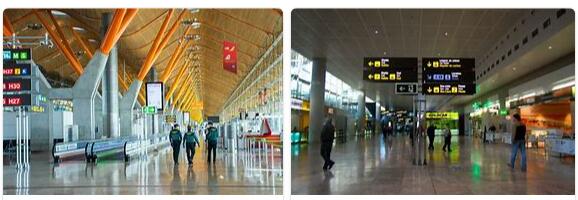
Airplane: Iberia (IB), the largest Spanish national airline, connects Spain with the rest of the world. Other airlines that offer connections to and from Spain include Air Lingus (EI), Air Berlin (AB), Air Europa (UX), Air Madrid (DRI), Air Scotland (GRE), Alpi Eagles (E8), BMI (BD),British Airways (BA), Brussels Airlines (SN), LTU (LT), Meridiana (IG), Monarch (ZB), Royal Air Maroc (AT), Spanair (JK), Swiss (LX) and Vueling (VGL).
Airports: the most important hub for air traffic to and from Spain is Madrid’s Barajas Airport (Aeropuerto Barajas). However, numerous European flights also go to the airports of Barcelona (Aeropuerto del Prat), Málaga,Palma de Mallorca and Valencia. Charter flights and connections from low-cost airlines also fly direct to a number of regional airports, such as A Coruña, Alicante, Almería, Asturias, Bilbao, Girona, Ibiza, Jerezde la Fontera, Murcia, Reus and Seville.
Ship: Ferries regularly connect mainland Spain with the Canary Islands, Italy, North Africa – Algeria, Morocco and the Spanish enclaves of Ceuta and Melilla – as well as Great Britain. Most of the connections are operated by the national ferry company Acciona Trasmediterránea.
Ferries to Algeria, from Alicante to Oran and from Almerìa to Ghazaouet leave several times a day. Every weekend there is a ferry from Santa Cruz des Tenerife and Las Palmas de Gran Canaria to Cádiz. The trip from Santa Cruz takes about two days. Ferries connect Genoa and Barcelona up to three times a week and Civitavecchia (near Rome) and Barcelona around six times a week.
There are a number of ferry connections between Morocco and Spain. The routes are Melilla-Almería, Almería-Al Hoceima, Nador-Almería, Tangier-Gibraltar, Tangier-Algeciras, Ceuta-Algeciras and Tangier-Tarifa. The most heavily used routes are those between Algeciras and Tangier and Ceuta. Additional services are offered during rush hour from mid to mid September. Nevertheless, there may be bottlenecks on the Tangier-Tarifa route during this period, as many Moroccans living in Europe use the summer months to spend their holidays in Morocco. In addition, there is a weekly ferry service from Grandi Navi Veloci (Grimaldi) between Genoa (Italy) and Tangier, which runs via Barcelona.
Brittany Ferries ferries to Santander leave Plymouth several times a week from mid-March to mid-November. P&O Ferries and Acciona Trasmediterránea each operate ferries between Portsmouth and Bilbao several times a week. Another way to travel by ship from Great Britain to Spain is by speedboat from Dover to Dunkirk or from Dover to Calais with a connection to Spain.
Rail: the main Spanish rail lines towards the French border run along the Mediterranean coast and through the Basque Country. Another, smaller railway line runs inland across the Pyrenees from Latour-de-Carol to Barcelona. From Portugal, the main railway line runs from Lisbon via Extremadura to Madrid.
Direct trains connect Barcelona with Paris, Geneva, Zurich, Turin and Milan several times a week. A night train runs regularly between Madrid and Paris. Detailed timetable information and tickets are available on the website of the Spanish State Railways (RENFE).
The Paris-Barcelona connection starts at Paris-Austerlitz station. Intermediate stops are Orléans, Limoges, Perpignan, Figueres, Girona and Barcelona-Sants. The Paris-Madrid connection has stops in Orléans, Blois, Poiters, Vitoria, Burgos and Valladolid. Both connections are relatively expensive. Other connections from Paris to Madrid require a change, for example in Irún. The situation is similar with alternative train connections between Paris and Barcelona. There are change options there, for example in Montpellier and Narbonne. Talgo trains run several times a day from Montpellier to Barcelona and then on to Murcia. There is also a daily slow night train from Paris to Latour-de-Carol, from where a regional train ensures the onward journey to Barcelona.
A night train runs daily between Lisbon and Madrid. Another goes to Irun. If you want to travel by train from Great Britain to Spain, take the Eurostar from London to Paris and use one of the connecting connections there.
Car: if you travel to Spain with your own car, you need a driver’s license as well as the vehicle documents and the green insurance certificate. If you have a European accident report form with you, you can make a lot of things easier in the event of an accident. Every vehicle must have a national registration number and be equipped with a warning triangle, spare lamps, a fire extinguisher and a first aid kit. In Spain, a reflective safety vest is also compulsory.
Spain is ideal for motorcycle tours. Therefore, in summer, motorcyclists populate the country’s roads in droves.
Bus: Eurolines buses connect Spain with almost all major cities in Europe. However, many connections are only offered once a week. Regular buses connect Andorra with Barcelona and other destinations in Spain (including Madrid) and France.
From Madrid and Barcelona there are daily long-distance buses to Paris and more than 20 other French cities. Long-distance buses from London start at Victoria Station, stop over in Paris and take travelers to Barcelona or Madrid after about a day.
Buses from Morocco go to Tangier. From there a ferry goes to Algeciras. From Algeciras there are bus connections to the main Spanish cities. One of the companies that serve this route is ALSA.
AutoRes operates daily buses between Lisbon and Madrid. Intermediate stop is Badajoz. Other bus connections between the Portuguese capital and Spain lead to Seville (via Aracena), to Malaga (via Badajoz), to Seville, Cádiz, Algeciras and the Costa del Sol. Other buses run from Lisbon to Granada (via Albufeira), Huelva, Seville, Malaga and Almuñécar. Other connections run north via Porto to Tui, Santiago de Compostela and La Coruña in Galicia. Local buses cross the border near Huevla (Andalusia), Badajoz (Extemadura) and Ourense (Galicia).